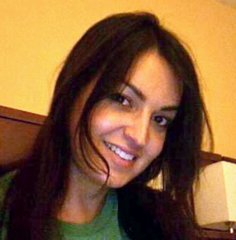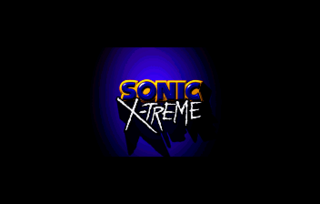Christina Coffin
From Sega Retro

|
| Christina Ann Coffin |
|---|
| Place of birth: United States |
| Date of birth: 197x (age 44-54) |
| Employment history:
Divisions:
Divisions:
Divisions:
|
| Role(s): Programmer[2], Engineer[2] |
| Education: University of California San Diego (Bachelor of Computer Science; 1990) |
| Forum user name: ChristinaCoffin |
| Twitter: @ChristinaCoffin |
Christina “Chris” Ann Coffin is an American video game programmer, software engineer, and visual effects artist.[2] With a vast wealth of programming experience dating back to the early 1980's, she was first hired by Sculptured Software in 1994, eventually migrating to Sega Technical Institute one year later. Serving as the division's Technical Director, she oversaw the production of a number of Sega of America's Saturn projects, even working on the system's Western development hardware.
Coffin is perhaps most associated today with her "boss engine" from the cancelled Sonic X-treme, for which she developed one of the game's few instances of a playable framerate. While she departed Sega in 1998, Coffin remains active in the video game industry and currently specializes in rendering, optimization, low-level programming, and visual effects.[3][2]
Contents
Career
Christina Coffin acquired her first computer at the age of 9 - a VIC-20.[2] After typing in her first BASIC program, and realizing she could now code her own games instead of asking her parents to purchase them, she quickly grew an affinity for video game programming and found herself coding games in her free time. After later acquiring an Amiga 500[2][4], and being exposed to its burgeoning demoscene, Coffin grew well-acquainted enough with the system to build a small library of demos, and continued creating games on her own for some time.[2]
While Coffin was completing her computer science degree at University of California San Diego in 1994, she saw a classified ad in a local San Diego paper advertising an available programming position at nearby Sculptured Software. Initially shocked to see what was her first exposure to the video game industry proper, and feeling like her life could use a more relevant change of direction, she applied for the job, bringing a number of her projects and Amiga demos to the interview. Despite her lack of professional experience, her visible passion and desire to create something meaningful shone through, and she was soon hired as one of the company's junior programmers.[2] She would work at Sculptured Software for about a year, where she saw the company transition from 16-bit to 32-bit hardware[2], and experienced firsthand the challenges inherent in making the leap to 3D programming.
Sega Technical Institute
- Main article: Sega Technical Institute.
Christina Coffin was hired by Sega of America in 1995[5] as Technical Director of its semi-independent development studio Sega Technical Institute. Working in a number of roles within the two companies, she notably served as programmer of the Sega Saturn's Sega Graphics Library development tools[5], acted in a development and advisory role at Sega of America's various R&D subsidiaries[5], and assisted the company's affiliated third-party developers with their technical support questions.[5]

She would later serve as Technical Advisor on the upcoming Sega Dreamcast[5], programming the system's core software libraries and playing a significant role in its engineering[5] - notably the first time the American division of Sega would have such a direct role in a home system's production. Through her time at the company, Coffin experienced developing for a number of different platforms and architectures - the Saturn, Dreamcast, Windows PC, Silicon Graphics workstations, arcade hardware, and various prototype systems.[5] She eventually left the company in early 1998, migrating to a Software Architect position at Konami Computer Entertainment America that March.[5]
Coffin's name is perhaps most associated today with her programming work on the boss fight engines during the latter half of the cancelled Sonic X-treme's development cycle. While much of the project was fraught with technical issues and unacceptable framerates, Coffin's boss engines were notably smoother and more stable, and were one of few sections of gameplay which were actually playable by the public. However, she and fellow developer Chris Senn found themselves so overworked by the end of development that they both developed serious illnesses, resulting in the project's ultimate cancellation.[6]
Later career
While working at Konami Computer Entertainment America, Coffin continued to utilize her previous experience when developing Konami's Sega Dreamcast core programming libraries and development tools[5], and would remain working in the company's numerous R&D roles until September 1999[5], where she departed for a brief one-year stint with Origin Systems in a server programming and maintenance role for Ultima Online.[5]
In January 2000, she accepted a Senior Programmer position at Sunset Entertainment, again working in the company's R&D roles, and this time specializing in graphics software, development tools, and game porting[5]; her experience with the Dreamcast again remained useful, not only assisting Sunset Entertainment with their Sega-related projects, but also having a significant development role in the November 2000 basketball game ESPN NBA 2Night.[5]
She began working at Rockstar San Diego in October 2002[5], where she primarily held the same R&D responsibilities as her previous positions, and played a significant role in production and development of a number of the studio's games. Coffin later held roles at Ubisoft[5], Blue Fang Games[5], and most notably Swedish developer DICE[5], where she worked as the company's Platform Specialist Senior Engineer[2], before eventually founding the nearby independent game development company Light & Dark Arts in December 2011.[5]
Since then, Coffin has remained in the video game industry and has acted in a number of roles, particularly the programming and maintenance of game engines[5], and also frequently relates her personal experiences and thoughts as a woman in the game industry - something for which she earned the 2011 International Game Developers Association Women in Gaming Award (Engineering).[7] She also became a member of the Advisory Board of the annual Game Developers Conference in 2014[3], and occasionally delivers professional talks on game programming and development.[8]
Misgendering
Due to her nickname Chris, Coffin sometimes found herself misgendered by the very industry she worked in. A July 1996 article for Sonic X-treme published by Game Players magazine (largely a Sega of America-authored promotional piece) misattributes a photograph of an unknown male STI developer with Coffin, but correctly attributes her boss engine responsibilities to her name. As a result, the magazine referred to Coffin as a male for the remainder of the piece.[9] In the article's September 1996 follow-up, Game Players again correctly attributes her work with the SGL library to her name, but continued referring to Coffin as a male[10], helping create long-standing confusion over Coffin's identity and work while at Sega Technical Institute.
Later, in the Saturn version of Quake, Coffin was again misgendered as a male, credited in-game "for his wisdom" in assisting the project.[11] This mistake was caught in time for the printing of the game's manual, where it was corrected to "for the wisdom".[12] Miscommunications like this seem to have influenced producer Mike Wallis' memories of Sonic X-treme, who further mistook Chris Coffin's gender in a notable June 2002 interview on the topic; again, Coffin's work on the game was correctly attributed to her name, but she is referred to as a male three times.[13] The game's designer, Chris Senn, later inadvertently repeated the same mistake when assembling a compilation of X-treme-related history for his Sonic Xtreme FAQ.[6]
This confusion, compounded with her preference for isolating herself from others during her work[14], eventually resulted in a significant portion of Sega-related history misgendering her as a male. Despite Coffin (a Sonic Retro member) specifically creating a June 21, 2006 forum post to explicitly confirm her identity[15], and even speaking with forum user JoeBroe64 in September 2021 to deny rumors she received a sex change, this error continues to exist in some form, printed in physically-published history books released as late as 2016.
Quotes
| “ | I want to make sure I’m doing what I love. And I want to be able to look back on my life and say "Wow! I made all these cool games and a lot of people enjoyed them." That’s what would make me feel like I’ve done something useful with my life. | „ |
— Christina Coffin[2] | ||
Production history
- Quake (Saturn; 1997) — Special Thanks[12] (as Chris "Applejack" Coffin)
- ESPN NBA 2Night (Dreamcast; 2000) — Programmers (as Christina Ann Coffin)
- ESPN NBA 2Night (Dreamcast; 2000) — Artists (as Christina Ann Coffin)
- Sonic X-treme (Saturn; unreleased) — Boss Programming (as Chris Coffin)
- Sonic X-treme (Saturn; unreleased) — Conceptual Gameplay Design (as Chris Coffin)
Interviews
Photographs
- Main article: Photos of Christina Coffin
External links
- Official website (Wayback Machine)
- Christina Coffin at LinkedIn
- Christina Coffin at Twitter
- Christina Coffin at MobyGames
- Women In Gaming 2011 Award Winners Announced article by Annette Gonzalez at Game Informer
References
- ↑ 1.00 1.01 1.02 1.03 1.04 1.05 1.06 1.07 1.08 1.09 1.10 1.11 1.12 1.13 1.14 1.15 1.16 1.17 1.18 1.19 1.20 1.21 1.22 1.23 1.24 1.25 1.26 https://www.linkedin.com/in/christinacoffin/details/experience/
- ↑ 2.00 2.01 2.02 2.03 2.04 2.05 2.06 2.07 2.08 2.09 2.10 2.11 2.12 Interview: Christina Coffin (2011-03-10) by H. Brun
- ↑ 3.0 3.1 https://www.gamedeveloper.com/audio/gdc-2014-adds-board-members-calls-for-talk-submissions (Wayback Machine: 2022-07-05 06:06)
- ↑ https://www.mobygames.com/user/sheet/userSheetId,71745/v,sl/ (Wayback Machine: 2021-10-30 09:31)
- ↑ 5.00 5.01 5.02 5.03 5.04 5.05 5.06 5.07 5.08 5.09 5.10 5.11 5.12 5.13 5.14 5.15 5.16 5.17 5.18 https://www.linkedin.com/in/christinacoffin/
- ↑ 6.0 6.1 http://www.senntient.com:80/projects/xtreme/FAQ.html (Wayback Machine: 2011-03-17 06:48)
- ↑ https://www.gameinformer.com/b/news/archive/2011/03/03/women-in-gaming-award-winners.aspx (Wayback Machine: 2021-04-21 19:54)
- ↑ https://gdconf.com/news/come-level-vfx-coding-skills-gdc-2018 (Wayback Machine: 2022-12-06 17:02)
- ↑ Game Players, "Vol. 9 No. 7 July 1996" (US; 1996-06-11), page 42
- ↑ Game Players, "Vol. 9 No. 9 September 1996" (US; 1996-08-06), page 55
- ↑ https://www.youtube.com/watch?v=YwQOQS5_P3U
- ↑ 12.0 12.1 File:Quake sat us manual.pdf, page 18
- ↑ Interview: Mike Wallis (2002-06) by Pachuka
- ↑ Interview: Don Goddard (2008-05) by hxc
- ↑ https://forums.sonicretro.org/index.php?threads/presenting.7325/page-3#post-128745 (Wayback Machine: 2023-03-01 03:26)